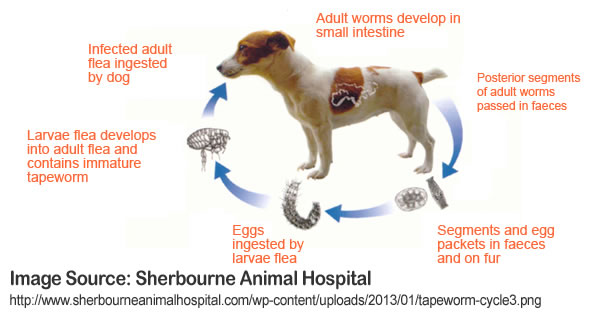
Tapeworms are common pet health concerns among both dogs and cats. These annoying parasites live in the small intestines of your pet and can vary in length from half an inch to several feet long. Tapeworms fasten themselves to the intestinal walls with hooked teeth and feed off of your dog or cat's blood. The body of one of these parasites is made up of several tiny segments that contain the worm's eggs. When your pet eliminates, some of these segments are passed out of the body with the feces. However, the head of the worm remains intact and fastened to the intestinal wall feeding off of blood and growing new segments.
How Tapeworms Affects Your Pet
There are basically three types of tapeworms, and they are known as Dipylidium caninum, Taenia and Echinococcus. The most common form found in pets is Dipylidium caninum, which your pet can acquire by ingesting infected fleas or lice. Another form of tapeworm that is common in cats is Taenia. Taenia can be acquired when your pet eats an infected rodent, fish or rabbit. If your dog or cat acquires Dipylidium caninum or Taenia, it will experience mild to severe anal itching, a change in its appetite and mild to moderate anemia depending on how severe the infestation is. Echinococcus is rare in dogs and cats; however, they can be found in deer, elk and many farm animals. These tapeworms can be acquired when dogs, cats or humans eat infected, uncooked meat. These parasites can be quite harmful and can cause serious illness and even death.
Common Symptoms of Tapeworms
The symptoms that your pet may exhibit if it has tapeworms will vary depending on the severity of the infestation, your pet's age and its overall health. However, some common symptoms of tapeworms are as follows. Common Symptoms of Tapeworms in Pets: Loss of Weight, Changes in Appetite, Loose Stools or Diarrhea, Occasional Bouts of Lethargy, Varying Degrees of Anemia, Single Worm Segments or Long Strands Emerging from the Anus, Live Tiny, White Worms in Stools and Tiny Rice-Like Matter Stuck to Bedding or Fur Around the Anus.
Treatments for Tapeworms
The treatment that will be necessary for your pet if it has this condition depends on how heavy the infestation is. In some cases, a simple over-the-counter de-worming treatment can be effective. One of the most common medications used for killing tapeworms in pets is Praziquantel, or Droncit. You can find this medicine online or in many pet stores. However, in the case of heavy infestations, your pet will need to see a veterinarian. Your vet will either give your dog or cat an injection or oral dose of Praziquantel to kill the worms. If your dog is severely anemic, IV therapy may be necessary as well. Typically, a second treatment will be required to kill any re-infestations. Additionally, it is essential that you treat your home to avoid re-infestations. Keep your pet's areas clean and maintain a regular flea treatment regime. Washing and heat-drying your dog or cat's bedding can also help kill any flea or tapeworm eggs.
Breeds Affected
Any breed of dog or cat can get tapeworms, and they can infest your pet no matter what age it is.
Pet Insurance
When adding a dog or cat to your family you want to make sure your pet is happy, healthy and protected. During its lifetime your pet is exposed to many illnesses and diseases and some breeds are affected by a congenital disease which is a condition existing at birth. At these moments when your pet is ill or maybe needs surgery, you want to be protected for the unexpected and high veterinarian costs.